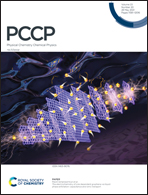Site-selective soft X-ray absorption as a tool to study protonation and electronic structure of gas-phase DNA
Abstract
The conformation and the electronic structure of gas-phase oligonucleotides depends strongly on the protonation site. 5′-d(FUAG) can either be protonated at the A-N1 or at the G-N7 position. We have stored protonated 5′-d(FUAG) cations in a cryogenic ion trap held at about 20 K. To identify the protonation site and the corresponding electronic structure, we have employed soft X-ray absorption spectroscopy at the nitrogen K-edge. The obtained spectra were interpreted by comparison to time-dependent density functional theory calculations using a short-range exchange correlation functional. Despite the fact that guanine has a significantly higher proton affinity than adenine, the agreement between experiment and theory is better for the A-N1 protonated system. Furthermore, an inverse site sensitivity is observed in which the yield of the nucleobase fragments that contain the absorption site appears substantially reduced, which could be explained by non-statistical fragmentation processes, localized on the photoabsorbing nucleobase.

- This article is part of the themed collection: 2021 PCCP HOT Articles


 Please wait while we load your content...
Please wait while we load your content...